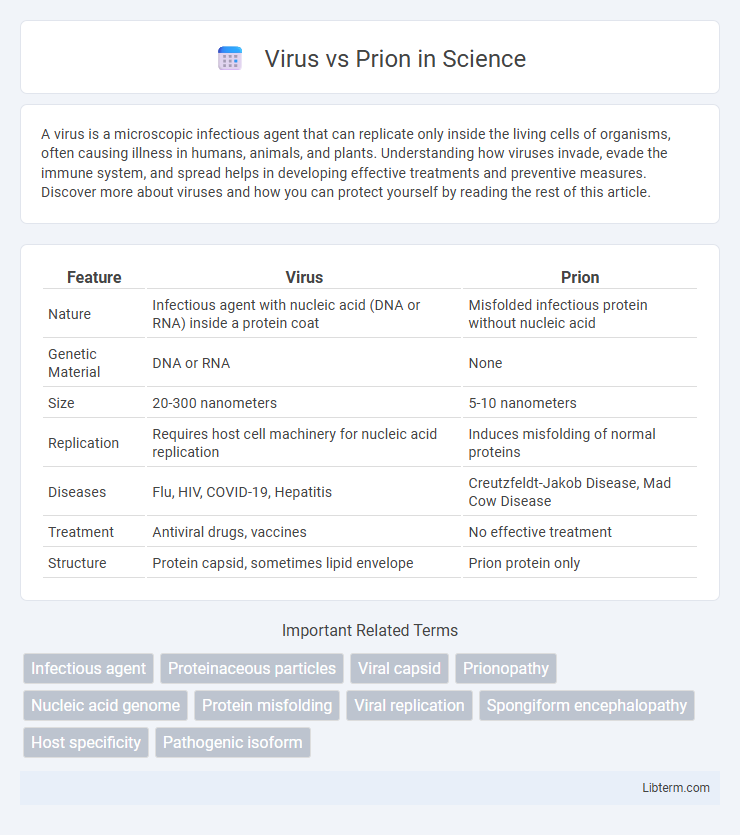A virus is a microscopic infectious agent that can replicate only inside the living cells of organisms, often causing illness in humans, animals, and plants. Understanding how viruses invade, evade the immune system, and spread helps in developing effective treatments and preventive measures. Discover more about viruses and how you can protect yourself by reading the rest of this article.
Table of Comparison
| Feature | Virus | Prion |
|---|---|---|
| Nature | Infectious agent with nucleic acid (DNA or RNA) inside a protein coat | Misfolded infectious protein without nucleic acid |
| Genetic Material | DNA or RNA | None |
| Size | 20-300 nanometers | 5-10 nanometers |
| Replication | Requires host cell machinery for nucleic acid replication | Induces misfolding of normal proteins |
| Diseases | Flu, HIV, COVID-19, Hepatitis | Creutzfeldt-Jakob Disease, Mad Cow Disease |
| Treatment | Antiviral drugs, vaccines | No effective treatment |
| Structure | Protein capsid, sometimes lipid envelope | Prion protein only |
Introduction: Understanding Viruses and Prions
Viruses are microscopic infectious agents composed of genetic material--either DNA or RNA--encased in a protein coat, capable of replicating only within living host cells. Prions are misfolded proteins that induce abnormal folding in normal proteins, leading to neurodegenerative diseases without involving nucleic acids or traditional infection pathways. Understanding their fundamental differences highlights unique mechanisms of infection and disease progression in viral and prion-related disorders.
Defining Viruses: Structure and Function
Viruses are microscopic infectious agents composed of genetic material, either DNA or RNA, encased within a protein coat called a capsid, sometimes surrounded by a lipid envelope. Their structure enables them to attach to host cells and inject their genetic material, hijacking the host's cellular machinery to replicate. Unlike prions, viruses contain nucleic acids essential for encoding the proteins facilitating infection and propagation within living organisms.
Prion Basics: Unraveling Their Unique Nature
Prions are infectious agents composed solely of misfolded proteins, lacking nucleic acids, which distinguishes them from viruses that contain DNA or RNA. These abnormal prion proteins induce normal proteins in the host brain to misfold, leading to neurodegenerative diseases like Creutzfeldt-Jakob disease and bovine spongiform encephalopathy. Their resilience to conventional sterilization and inability to trigger an immune response make prions uniquely challenging pathogens in medical science.
Modes of Infection: How Viruses and Prions Spread
Viruses spread primarily through direct contact, respiratory droplets, bodily fluids, or contaminated surfaces, enabling rapid transmission between hosts. Prions propagate by inducing abnormal folding of normal proteins, often transmitted through ingestion of infected tissue, medical procedures, or inherited genetic mutations. Unlike viruses, prions resist standard sterilization, making their modes of infection particularly challenging to control.
Replication Strategies: Viruses vs Prions
Viruses replicate by hijacking the host cell's machinery to produce viral components, assembling new virus particles that spread infection. Prions replicate through a unique mechanism of protein misfolding, where abnormal prion proteins induce normal proteins to change shape, propagating the disease without nucleic acids. This fundamental difference in replication strategies distinguishes viruses, which require genetic material, from prions, which rely solely on protein conformation changes.
Diseases Caused by Viruses and Prions
Viruses cause a wide range of diseases including influenza, HIV/AIDS, and hepatitis, which affect the respiratory, immune, and liver systems respectively. Prions are responsible for rare but fatal neurodegenerative diseases such as Creutzfeldt-Jakob disease and bovine spongiform encephalopathy (mad cow disease), leading to brain tissue damage. While viral diseases often involve immune response and antiviral treatments, prion diseases currently have no cure and are characterized by progressive brain damage.
Diagnosis: Identifying Viral and Prion Infections
Diagnosis of viral infections commonly relies on molecular techniques such as PCR, antigen detection, and serological assays to identify viral RNA, proteins, or antibodies. In contrast, prion infections lack nucleic acids, making diagnosis dependent on detecting misfolded prion proteins through methods like Western blot, immunohistochemistry, or real-time quaking-induced conversion (RT-QuIC). These diagnostic approaches are critical in distinguishing viral pathogens from prion-induced neurodegenerative disorders.
Treatment and Prevention Options
Antiviral drugs and vaccines serve as primary treatment and prevention methods for viruses, targeting viral replication and boosting immune response to reduce infection rates. In contrast, prion diseases lack effective treatments or vaccines, with prevention relying mainly on strict sterilization protocols and avoiding consumption of contaminated tissue to block transmission. Research on prion-targeted therapeutics remains limited due to the unique proteinaceous nature and resistance of prions to conventional disinfection methods.
Key Differences Between Viruses and Prions
Viruses consist of genetic material (DNA or RNA) enclosed in a protein coat and require host cells to replicate, while prions are misfolded proteins that propagate by inducing abnormal folding in normal proteins without any nucleic acids. Viruses cause infections by hijacking cellular machinery, whereas prions cause neurodegenerative diseases through protein aggregation and tissue damage. The key difference lies in their composition: viruses are nucleic acid-based infectious agents, prions are infectious proteins lacking genetic material.
Conclusion: Virus vs Prion – Implications for Health
Viruses and prions differ fundamentally in structure and replication, with viruses containing nucleic acids and prions composed solely of misfolded proteins, impacting their respective transmission and pathogenesis. Viral infections often provoke immune responses and can be targeted by antiviral drugs and vaccines, whereas prion diseases are invariably fatal and resistant to conventional therapies due to prions' unique proteinaceous infectious nature. Understanding these differences is crucial for developing effective prevention and treatment strategies to mitigate health risks associated with both infectious agents.
Virus Infographic

 libterm.com
libterm.com